IOZ interrupts my dogmatic slumbers to correct my (well, not my, personally, but I know I've done it; I'm just too lazy now to search for the link) use of the term "Manichean" as denoting a black-and-white, simplistic view of moral issues. I'm joining la Rana in her(?) friendly demi-demurrer (scroll down from the linked post), protesting that the Manichees, complex and syncretic as their beliefs may have been, were, at bottom, dualists. They did draw a sharp distinction between light (good) and matter (bad).
This article, describing the result of a recent experiment by some Danish physicists, however, puts things in a new (ahem) light. While the ability to teleport light to matter doesn't negate their difference, it does underline their complimentary roles; that is, light as carrier of information and matter as its storage medium. So, if the carrier is good, how can the repository be bad? (Thanks to Keifus for the link.)
"[A] delightfully named blog", (Sewell Chan, New York Times). "[R]elentlessly eclectic", (Gary, Iowa City). Taxing your attention span since 2005.
Monday, October 09, 2006
Sunday, October 08, 2006
MLB playoff confession.
I fell for the conventional wisdom that the Mets, without Pedro, and especially without Pedro and El Duque, were doomed to fall to the Dodgers in the NLDS. My hope was that they could at least make it a five game series. That they could sweep it seemed (here I'm picturing Wallace Shawn in The Princess Bride) inconceivable.
Ah, well, it's still inconceivable that they could win it all. Or is it? (At least they won't have to deal with the Yanks' batting order, though they'll miss the opportunity to feast on Bronx pitching.)
Update: Twiffer sends me a slightly stale slice of The Onion.
Ah, well, it's still inconceivable that they could win it all. Or is it? (At least they won't have to deal with the Yanks' batting order, though they'll miss the opportunity to feast on Bronx pitching.)
Update: Twiffer sends me a slightly stale slice of The Onion.
Saturday, October 07, 2006
College football confession.
My prowess as a Gator prognosticator (two weeks ago, I predicted they would fall to LSU) took a hit today. I'm sticking with my forecast of a loss to Auburn next week, especially because Auburn was upset badly by Arkansas today (ergo the Tigers will be hungry and primed for revenge, while the Gators will be cocky and overconfident); also, it's at Auburn and they have often been a nemesis for Florida.
USF gets by UConn to even up their Big East record at one.
Update: Gators are ranked No. 2? Y'all War Eagle fans can relax. The Florida players' heads will be swelled so big they won't even be able to get their helmets on.
USF gets by UConn to even up their Big East record at one.
Update: Gators are ranked No. 2? Y'all War Eagle fans can relax. The Florida players' heads will be swelled so big they won't even be able to get their helmets on.
Wetlands at the Florida Aquarium
In an earlier post I mentioned that my daughter's favorite place in Tampa is the Florida Aquarium. Her favorite part of the Aquarium is the Wetlands exhibit.
On our visit last Monday, in the Springs portion of the exhibit we found this peninsula cooter resting, but with head up and alert, on a fallen limb.
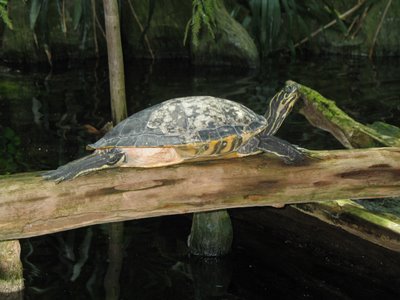
On a log below, this Barbour's map turtle seemed less than thrilled to be photographed.

Note that, in the linked article about Barbour's, the writer describes the Apalachicola River basin as "heaven", which is interesting considering Elvy Calloway's conjecture that it was the site of the Garden of Eden (see my post on Senecas, etc., below, linked at the beginning of this post).
A little futher along, Liz found and photographed this roseate spoonbill perched at the edge of the Mangrove Swamp sector.

The plumage trade of the late nineteenth century put some stress on the spoonbill population, but these birds are, fortunately, now fairly common around parts of the Gulf of Mexico coastline.
Unfortunately, the otters were snoozing in some dark recess of the exhibit. The gators were out, but difficult to photograph because of the high plexiglass walls separating them from visitors' fingers.
On our visit last Monday, in the Springs portion of the exhibit we found this peninsula cooter resting, but with head up and alert, on a fallen limb.

On a log below, this Barbour's map turtle seemed less than thrilled to be photographed.

Note that, in the linked article about Barbour's, the writer describes the Apalachicola River basin as "heaven", which is interesting considering Elvy Calloway's conjecture that it was the site of the Garden of Eden (see my post on Senecas, etc., below, linked at the beginning of this post).
A little futher along, Liz found and photographed this roseate spoonbill perched at the edge of the Mangrove Swamp sector.

The plumage trade of the late nineteenth century put some stress on the spoonbill population, but these birds are, fortunately, now fairly common around parts of the Gulf of Mexico coastline.
Unfortunately, the otters were snoozing in some dark recess of the exhibit. The gators were out, but difficult to photograph because of the high plexiglass walls separating them from visitors' fingers.
Si Waitzman, ? - 2006
Si and I were neighbors for many years. When I moved to Brooklyn Heights in 1983, he was living in my building. Si was an architect, and designed the rooftop deck on which my family, friends and I enjoyed many sunsets and Fourth of July fireworks displays. He was an outgoing, friendly man with a winning smile.
Besides an interest in architecture, something Si and I had in common was smoking. Some years ago, he began to lose his voice. Then I learned he had been diagnosed with throat cancer, and would need surgery. A month or so later, I was standing in front of our building having a cigarette when Si walked up to me and whispered, "You've got to quit that if you don't want to end up like me." His larynx had been removed, and with it his voice.
Si's advice weighed heavily with me: I quit cold turkey a few months later.
For the past few years, I would see him now and then (he had moved, but stayed in the neighborhood), and occasionally have a short chat - the most he seemed able to manage, as even whispering was evidently a strain on his throat. He was delighted when I told him I'd stopped smoking. Usually, I would see him on nice days, sitting at a table outside Starbucks on Montague Street. He would always give me a smile and a wave.
Today I heard from a neighbor that Si died. I'll miss him very much, and always be grateful for his advice.
Besides an interest in architecture, something Si and I had in common was smoking. Some years ago, he began to lose his voice. Then I learned he had been diagnosed with throat cancer, and would need surgery. A month or so later, I was standing in front of our building having a cigarette when Si walked up to me and whispered, "You've got to quit that if you don't want to end up like me." His larynx had been removed, and with it his voice.
Si's advice weighed heavily with me: I quit cold turkey a few months later.
For the past few years, I would see him now and then (he had moved, but stayed in the neighborhood), and occasionally have a short chat - the most he seemed able to manage, as even whispering was evidently a strain on his throat. He was delighted when I told him I'd stopped smoking. Usually, I would see him on nice days, sitting at a table outside Starbucks on Montague Street. He would always give me a smile and a wave.
Today I heard from a neighbor that Si died. I'll miss him very much, and always be grateful for his advice.
Thursday, October 05, 2006
A terrible beauty.
Walking from my daughter's school to my office this morning, I took the long way, by the Battery Park City esplanade. When I got to the North Cove yacht basin, I saw an antique-looking vessel docked at the southwest corner. She proved to be a replica of the slave ship Amistad, probably the one used in the movie of the same name.

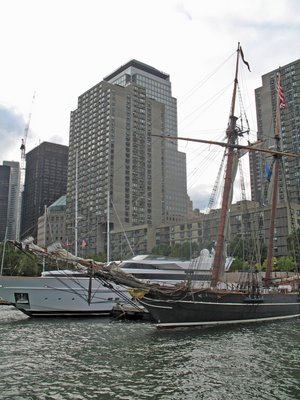
Ironically, slavers were among the most beautiful of ships, as this view of Amistad's long bowsprit, graceful hull and aftward-raked masts shows. Those built after the slave trade was outlawed were made small and speedy so as to evade detection by, and outrun if necessary, patrolling warships. Speed was also of the essence because their human "cargo", chained below decks, was altogether too perishable.


Ironically, slavers were among the most beautiful of ships, as this view of Amistad's long bowsprit, graceful hull and aftward-raked masts shows. Those built after the slave trade was outlawed were made small and speedy so as to evade detection by, and outrun if necessary, patrolling warships. Speed was also of the essence because their human "cargo", chained below decks, was altogether too perishable.
Tuesday, October 03, 2006
Senecas, spiritualism and Weird Florida
Every now and then, I'll encounter several things in my reading that are connected in some odd way, despite having been published at different times and in differing contexts. On Saturday, we flew to Tampa to be with my mother as she celebrated her 90th birthday. Early that morning, gathering reading material for the flight, I saw on the front page of the Sunday New York Times travel section (which is delivered on our doorstep with our Saturday paper) a teaser for an article on page 13 by Beth Quinn Barnard, headed "Seneca Folklore And Forest Trails - A ravine near Canandaigua, N.Y., is called the world's birthplace."
I stuck the travel section in my carry-on bag because I spent a good deal of time in the early part of my career in Seneca country, Western New York, and I'm interested in the creation myths of various cultures. According to the article, the Senecas, or Onondowaga ("People of the Great Hill") as they call themselves, believe their progenitors to have emerged from the earth at a place now called Clark's Gully, a ravine at the base of South Hill ("Nundawao" to the Senecas), an eleven hundred foot eminence at the southern end of Canandaigua Lake .
Thinking about Seneca legends made me recall conversations I'd had many years ago during my travels in Western New York. One of these had concerned a Spiritualist community called Lily Dale, near the village of Cassadaga in Chautauqua County, southwest of Buffalo. (There's a song called "Lilydale" on The Wishing Chair, the magnificent first album by 10,000 Maniacs, who came from nearby Jamestown, New York; you can hear it here.) During this conversation, I was told about a young man from Jamestown who had Seneca ancestry, and who visited one of the mediums at Lily Dale. When he entered the room where the medium sat, she seemed to look over one of his shoulders, and said, "Hello! I haven't seen you in a while. How are you?" Realizing this wasn't addressed to him, the young man remained silent for a minute while the medium seemed to listen to an inaudible reply. Finally, she looked him in the eye, and he said, "Who were you talking with?" "It's Cornplanter," she answered. "He says you're one of his favorite grandsons, and he keeps a close watch on you."
The Seneca creation myth also made me recall that, when my parents and I were moving from Eglin Air Force Base, in the western panhandle of Florida, to Tampa, we passed billboards on the highway west of Tallahassee urging us to turn off and see "The Original Garden of Eden". I later did some research on this, and found that an eccentric resident of that area, Elvy Calloway, had declared that a ravine on the Apalachicola River had to be the Biblical Eden. He reached this conclusion for various reasons, including the fact that the River splits into four branches nearby, and that various plants mentioned in Genesis can all be found growing there.
On Monday, I took my daughter to her favorite place in Tampa, the Florida Aquarium. (At age 12, she aspires to be a marine biologist. Oddly enough, I had exactly that ambition when I was her age. I'm hoping she'll stick with it.) As we surveyed the gift shop after our tour, I spotted a book with the title Weird Florida, by Charlie Carson (Sterling Press, New York, 2005). I opened it to see if it had an account of the "Garden of Eden". It did, and, to my surprise, a few pages away had a piece about a spiritualist community in Volusia County (near Daytona Beach) called Cassadaga. I assumed Cassadaga, Florida was founded by people who moved south from Lily Dale, since it bears the name of the New York village nearest to there. However, according to Weird Florida, the founder was a spiritualist from Iowa who, in 1875, contacted a Native American spirit. This spirit first directed him to visit another spiritualist in Wisconsin, then told them both that they were to found a spiritualist community in Florida. They traveled to Florida, where the spirit gave them precise directions as to where to establish the settlement.
So, nothing to do with Western New York, except that the spirit guide's name was "Seneca".
Update: I looked up the website for the Cassadaga, Florida spiritualist community, and found that George Colby, the founder, although he may have come there from Iowa, was "from New York". So, perhaps he grew up in or near the original Cassadaga.
I stuck the travel section in my carry-on bag because I spent a good deal of time in the early part of my career in Seneca country, Western New York, and I'm interested in the creation myths of various cultures. According to the article, the Senecas, or Onondowaga ("People of the Great Hill") as they call themselves, believe their progenitors to have emerged from the earth at a place now called Clark's Gully, a ravine at the base of South Hill ("Nundawao" to the Senecas), an eleven hundred foot eminence at the southern end of Canandaigua Lake .
Thinking about Seneca legends made me recall conversations I'd had many years ago during my travels in Western New York. One of these had concerned a Spiritualist community called Lily Dale, near the village of Cassadaga in Chautauqua County, southwest of Buffalo. (There's a song called "Lilydale" on The Wishing Chair, the magnificent first album by 10,000 Maniacs, who came from nearby Jamestown, New York; you can hear it here.) During this conversation, I was told about a young man from Jamestown who had Seneca ancestry, and who visited one of the mediums at Lily Dale. When he entered the room where the medium sat, she seemed to look over one of his shoulders, and said, "Hello! I haven't seen you in a while. How are you?" Realizing this wasn't addressed to him, the young man remained silent for a minute while the medium seemed to listen to an inaudible reply. Finally, she looked him in the eye, and he said, "Who were you talking with?" "It's Cornplanter," she answered. "He says you're one of his favorite grandsons, and he keeps a close watch on you."
The Seneca creation myth also made me recall that, when my parents and I were moving from Eglin Air Force Base, in the western panhandle of Florida, to Tampa, we passed billboards on the highway west of Tallahassee urging us to turn off and see "The Original Garden of Eden". I later did some research on this, and found that an eccentric resident of that area, Elvy Calloway, had declared that a ravine on the Apalachicola River had to be the Biblical Eden. He reached this conclusion for various reasons, including the fact that the River splits into four branches nearby, and that various plants mentioned in Genesis can all be found growing there.
On Monday, I took my daughter to her favorite place in Tampa, the Florida Aquarium. (At age 12, she aspires to be a marine biologist. Oddly enough, I had exactly that ambition when I was her age. I'm hoping she'll stick with it.) As we surveyed the gift shop after our tour, I spotted a book with the title Weird Florida, by Charlie Carson (Sterling Press, New York, 2005). I opened it to see if it had an account of the "Garden of Eden". It did, and, to my surprise, a few pages away had a piece about a spiritualist community in Volusia County (near Daytona Beach) called Cassadaga. I assumed Cassadaga, Florida was founded by people who moved south from Lily Dale, since it bears the name of the New York village nearest to there. However, according to Weird Florida, the founder was a spiritualist from Iowa who, in 1875, contacted a Native American spirit. This spirit first directed him to visit another spiritualist in Wisconsin, then told them both that they were to found a spiritualist community in Florida. They traveled to Florida, where the spirit gave them precise directions as to where to establish the settlement.
So, nothing to do with Western New York, except that the spirit guide's name was "Seneca".
Update: I looked up the website for the Cassadaga, Florida spiritualist community, and found that George Colby, the founder, although he may have come there from Iowa, was "from New York". So, perhaps he grew up in or near the original Cassadaga.
Friday, September 29, 2006
Welcome back, Decker.
The handsome little tug W.O. Decker, having had some needed maintenance work, has rejoined the small fleet of historic vessels on display at the South Street Seaport Museum. Here she is, tied up to the Ambrose lightship.


College football quickie.
Unholy exit 9! Rutgers stays undefeated, and probably keeps its place in the top 25, but at the expense of my alma mater.
Thursday, September 28, 2006
Goodbye, Pedro.
No complaints. You were vital to our getting here. Now we have to see if we can go on without you. I'm not giving up, yet.
Tuesday, September 26, 2006
Days of Awe
Hm . . . Memorable . . . what? (He peers closer.) Equinox, memorable equinox. (He raises his head, stares blankly front. Puzzled.) Memorable equinox? . . . (Pause. He shrugs his head shoulders, peers again at ledger, reads.) Farewell to--(he turns the page)--love.
-- Samuel Beckett, Krapp’s Last Tape
In Florida, autumn came
as a change in the light
in late afternoon,
around mid-October.
I hardly noticed it
until I was nineteen.
A girlfriend left me.
I wrote a poem, ephemeral
as the love it mourned.
At sixty, autumn seems
like that last song
by Dave Guard’s Trio,
vocal by Nick Reynolds,
later covered by Sinatra:
vintage wine, days decreasing.
And now, in Brooklyn
(I’ve lived life backwards:
Florida, Manhattan, Brooklyn),
an older voice whispers
gently, to my gentile ears,
L’shanah tovah.
-- Samuel Beckett, Krapp’s Last Tape
In Florida, autumn came
as a change in the light
in late afternoon,
around mid-October.
I hardly noticed it
until I was nineteen.
A girlfriend left me.
I wrote a poem, ephemeral
as the love it mourned.
At sixty, autumn seems
like that last song
by Dave Guard’s Trio,
vocal by Nick Reynolds,
later covered by Sinatra:
vintage wine, days decreasing.
And now, in Brooklyn
(I’ve lived life backwards:
Florida, Manhattan, Brooklyn),
an older voice whispers
gently, to my gentile ears,
L’shanah tovah.
Saturday, September 23, 2006
College football yawn.
Everything turned out pretty much as I predicted.
The Gators had a scare. My South Florida Bulls lost to a mediocre Big 12 team. At least some other Bulls, Buffalo, managed to play Auburn tough for three quarters.
Penn State failed to keep a narrow halftime lead, and fell to the Buckeyes. I've always had a soft spot for the Nittany Lions, as I was born, and my mother grew up, less than fifty miles from Happy Valley.
The other, local, Lions, Columbia, opened their season with a win over Georgetown. Of course, Georgetown football has been an afterthought since the days when they were called the Stonewalls.
Update: Holy Exit 9! Rutgers is ranked.
The Gators had a scare. My South Florida Bulls lost to a mediocre Big 12 team. At least some other Bulls, Buffalo, managed to play Auburn tough for three quarters.
Penn State failed to keep a narrow halftime lead, and fell to the Buckeyes. I've always had a soft spot for the Nittany Lions, as I was born, and my mother grew up, less than fifty miles from Happy Valley.
The other, local, Lions, Columbia, opened their season with a win over Georgetown. Of course, Georgetown football has been an afterthought since the days when they were called the Stonewalls.
Update: Holy Exit 9! Rutgers is ranked.
Friday, September 22, 2006
Penn's Landing
My hotel in Philadelphia was just a couple of blocks from Penn's Landing, a stretch of riverfront just south of the Ben Franklin Bridge that has been made into a waterside promenade and entertainment venue, as well as a permanent dock for a couple of historic ships, the cruiser U.S.S. Olympia, flagship of Admiral Dewey's "Great White Fleet" in the Spanish-American War, and the square rigger Mosholu, now made into a restaurant at the cost of having picture windows cut into her hull (see below):
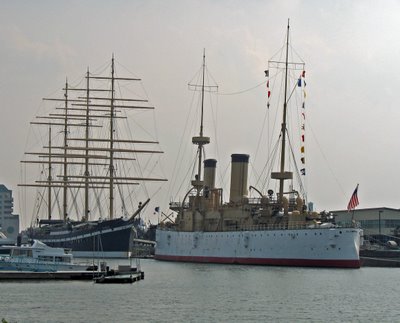
Across the Delaware, at Camden, the World War II veteran battleship U.S.S. New Jersey entertains visitors to her namesake state.
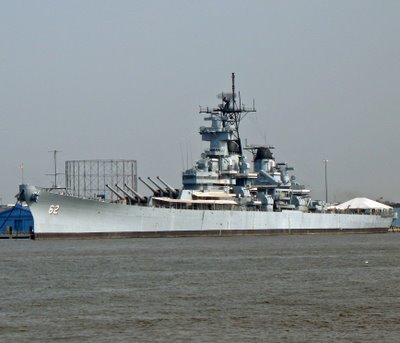
When I visited the Landing, the outdoor theater was presenting a festival of Russian culture.

Looking downriver, I could see the distinctive funnels and upper superstructure of the S.S. United States, last holder of the Blue Riband of the North Atlantic, docked at an otherwise disused pier. As explained in this fan website, her present owners, NCL America, hope to restore her to service as a cruise ship.

Near the upriver end of the Landing, the pretty barquentine Gazela was docked.
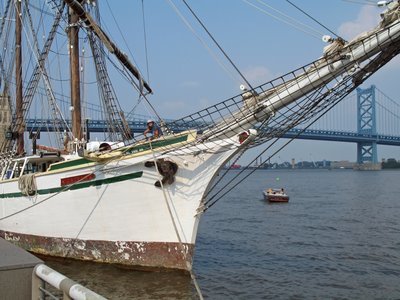
A rushing sound made me look up and see this commuter train going eastward across the Ben Franklin Bridge.

On the Landing's North bulwark, the old tug Jupiter, nicely preserved, sat tied to a barge.

Crossing the bridge that connects the Landing to Market Street, I got this shot of the Center City skyline.
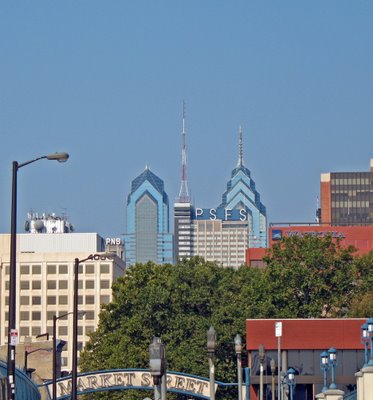
Update: Topazz demands that I provide my account of the Philly Fraymeet itself, so here goes: The food and drinks were sublime, the ambience divine, the conversation scintillating, Chango looks just like his photographs on FrayMates, and Topazz's hair shimmers like a Magellanic cloud.
But seriously, folks -- I can't thank Rundeep and Topazz enough for putting together a superb event.

Across the Delaware, at Camden, the World War II veteran battleship U.S.S. New Jersey entertains visitors to her namesake state.

When I visited the Landing, the outdoor theater was presenting a festival of Russian culture.

Looking downriver, I could see the distinctive funnels and upper superstructure of the S.S. United States, last holder of the Blue Riband of the North Atlantic, docked at an otherwise disused pier. As explained in this fan website, her present owners, NCL America, hope to restore her to service as a cruise ship.

Near the upriver end of the Landing, the pretty barquentine Gazela was docked.

A rushing sound made me look up and see this commuter train going eastward across the Ben Franklin Bridge.

On the Landing's North bulwark, the old tug Jupiter, nicely preserved, sat tied to a barge.

Crossing the bridge that connects the Landing to Market Street, I got this shot of the Center City skyline.

Update: Topazz demands that I provide my account of the Philly Fraymeet itself, so here goes: The food and drinks were sublime, the ambience divine, the conversation scintillating, Chango looks just like his photographs on FrayMates, and Topazz's hair shimmers like a Magellanic cloud.
But seriously, folks -- I can't thank Rundeep and Topazz enough for putting together a superb event.
Thursday, September 21, 2006
Believe!
So says Ron Borges of the Boston Globe and MSNBC.
Pedro's performance tonight - four shutout innings before a shaky fifth - gives reason for optimism.
Did I really use the "O" word?
Pedro's performance tonight - four shutout innings before a shaky fifth - gives reason for optimism.
Did I really use the "O" word?
Sunday, September 17, 2006
College football wrap-up.
Gators survive (by the skin of their teeth), but 'Noles don't, losing the Battle of the Bowdens. I didn't check the odds, but I'd guess the latter was considered an upset, what with Clemson coming off a loss to Boston College, and FSU having beaten Miami (even though it could barely get by Troy State last week). But the rout of the 'Canes by Louisville shows that Miami was overrated in preseason polls; so, also, may have been the lads from Tallahassee.
Next week, the Gators host Kentucky. Even though it's in the Swamp, I'm predicting an early scare, perhaps with the Wildcats ahead at the half. Florida always comes off a big game flat, win or lose. After Kentucky, they face the gauntlet of 'Bama, LSU, Auburn and Georgia. My guess is, they crest the Tide this year, but the Bayou Bengals ruin their homecoming. The other Tigers then make it two losses in a row, but the Gators regroup to continue their recent ownership of the Ur-rival Dawgs. Bookmark this, and we'll see.
My South Florida Bulls stay undefeated, thanks to an upset of their Interstate 4 rivals, the Central Florida Knights. Alas, I see their run ending next week in Lawrence, Kansas. The Jayhawks are no great shakes these days, but they are a team with a history, tra-di-shon (remember Gayle Sayers?) and all that, so, of course, they'll prevail. (Hey! Wait a minute. USF beat Pitt a couple of years ago. Yeah, but that was just one of those exceptions that prove a rule.)
Big news is Michigan's upset of Notre Dame. Yawn. One establishment team over another. I guess I like Michigan marginally better because they aren't lionized in quite the obnoxoius way ND is, what with "subway alumni", their own "Notre Dame Central" on the MSNBC college grid page, ad nauseam.
One reason to like ND: I remember seeing a painting (Neiman?) of an early 1970s Irish vs. Southern Cal game, in which ND fans had hung a banner reading "Trojans burst under pressure".
Next week, the Gators host Kentucky. Even though it's in the Swamp, I'm predicting an early scare, perhaps with the Wildcats ahead at the half. Florida always comes off a big game flat, win or lose. After Kentucky, they face the gauntlet of 'Bama, LSU, Auburn and Georgia. My guess is, they crest the Tide this year, but the Bayou Bengals ruin their homecoming. The other Tigers then make it two losses in a row, but the Gators regroup to continue their recent ownership of the Ur-rival Dawgs. Bookmark this, and we'll see.
My South Florida Bulls stay undefeated, thanks to an upset of their Interstate 4 rivals, the Central Florida Knights. Alas, I see their run ending next week in Lawrence, Kansas. The Jayhawks are no great shakes these days, but they are a team with a history, tra-di-shon (remember Gayle Sayers?) and all that, so, of course, they'll prevail. (Hey! Wait a minute. USF beat Pitt a couple of years ago. Yeah, but that was just one of those exceptions that prove a rule.)
Big news is Michigan's upset of Notre Dame. Yawn. One establishment team over another. I guess I like Michigan marginally better because they aren't lionized in quite the obnoxoius way ND is, what with "subway alumni", their own "Notre Dame Central" on the MSNBC college grid page, ad nauseam.
One reason to like ND: I remember seeing a painting (Neiman?) of an early 1970s Irish vs. Southern Cal game, in which ND fans had hung a banner reading "Trojans burst under pressure".
Saturday, September 16, 2006
The Philly cheesesteak quest.
As I noted before, last weekend I went to Philadelphia for a meeting of Fray particpants from across the country. After arriving at 30th Street Station around 11:45 A.M., I took a cab to my hotel at Arch and 4th Streets, in the historic district. Once I had unpacked, I was ready for lunch. Not any lunch. I wanted the real Philly cheesesteak sandwich. Fray friend Topazz had recommended Pat's for the quintessential version. I consulted a tourist guide and map, and determined that Pat's was a good 45 minute walk away. Being as keen to see the city as I was to fill my belly, I decided to take the walk.
I walked westward across 4th to Market, then turned right to head towards 9th. After a couple of blocks, I paused to get my obligatory shot of Independence Hall.
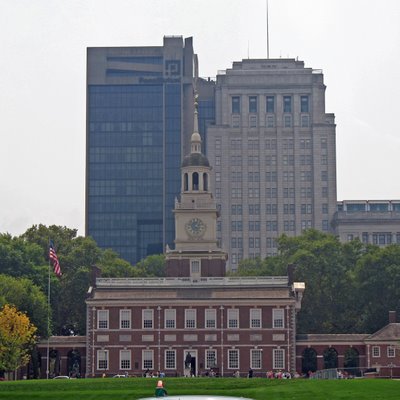
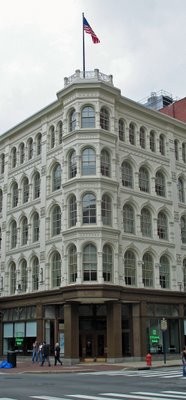
Continuing across Market, I came to a magnificent example of late 19th century cast iron department store architecture. There are many buildings in this style in the "Ladies' Mile" section of New York, but I reckoned this an especially fine specimen. It is the former Lit Bros. store, now subdivided into a few street level chain shops and offices above.
Fortunately, the building has been preserved.
To the right of the "Lit's" sign facing the intersection is a sign that reads, "Hats trimmed free of charge." I wonder if Carmen Miranda ever came to Philly to take advantage of that offer.
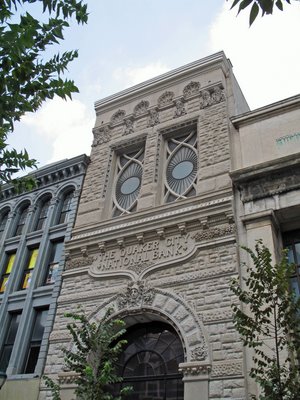
I'm not sure why, but smaller cities like Philadelphia seem to have much more exuberant vernacular architecture than New York. Perhaps it's because architects working in cities with less critical oversight felt less inhibited.
In any event, note the "eyes" on The Quaker City National Bank Building. Revel in the playful texture of the facade, and the "thought balloon" containing the institutional name, suspended above the helmet of the figure on the keystone of the arch.
I turned left off Market onto 9th and walked southward. After a few blocks, I started to get into the heart of old Italian South Philly. Several blocks were taken over by outdoor market stalls selling produce of all descriptions.

Finally, I arrived at my destination, and found the end of a long, but fairly rapidly moving line.
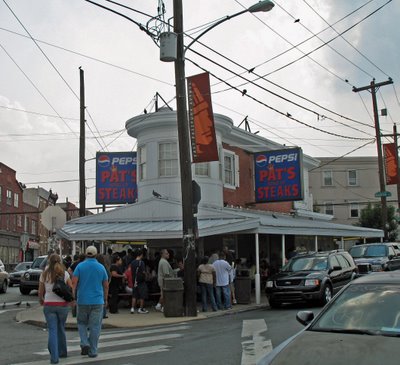
The questions of the moment were Cheez-Whiz or Provolone, and "with" (or, as Topazz had coached me, "wit") or "without". (The last refers to onions.) I had read that cheesesteak cognoscienti prefer "Whiz"; the issue of onions is left to individual taste. When I got to the window, and a little, brush-cut pitbull of a man barked "Next!", I said, "One Whiz wit, please." (The last word probably gave me away as a tourist.)
The sandwich proved worth the walk and the seven bucks. The meat was sliced thin and a bit overdone for my taste. The logic of "Whiz" was readily apparent; its semiliquid state allows it to permeate every crevice, and its unsubtle flavor perked up the beef nicely. The bread was an ideal companion for these ingredients; soft and spongy, but still firm enough to keep its shape and hold the filling, while absorbing the cheese and the meat juice. The onions were a bit of a letdown -- heavily sauteed and droopy, like those you get from hot dog carts. Next time, I may try a "Whiz witout". Nevertheless, I was more than satisfied.
As I started back to my hotel, I noticed Passyunk Avenue heading off at a northeastward angle, forming a hypoteneuse to the triangle whose legs of Market and 9th I had walked to get here. At the apex of the triangle sat Pat's gaudy competitor, Geno's.

I decided to take the Passyunk shortcut, which would afford me the opportunity to see some different things on the way back. After walking a few blocks, I became very thirsty. I was sure I'd soon come to a little deli where I could get a bottle of water, but all I could find were residences and auto supply stores.
Finally, after many blocks, I saw this sign. I was ready to "take the plunge", but the plunge wasn't ready for me, as a sign on the door said the place didn't open until 5:00 P.M., and it was only 2:15.

Fortunately, after another couple of blocks, I found this angel of mercy, attended by two cherubs (one of whom is visible just inside the door) at the corner of Passyunk and Catherine.
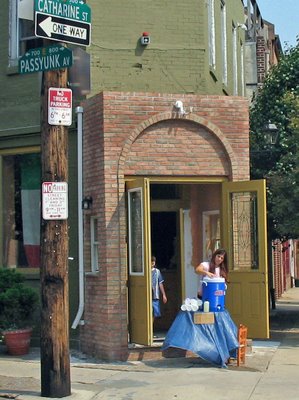 The lemonade they vended was a perfect chaser to a Pat's cheesesteak, having a crisp tartness that banished the lingering salinity of the Cheez-Whiz and onions.
The lemonade they vended was a perfect chaser to a Pat's cheesesteak, having a crisp tartness that banished the lingering salinity of the Cheez-Whiz and onions.
Passyunk Avenue came to an end a few blocks later, near this building, on which two more cherubs fluttered in attendance on an unlikely monarchy.
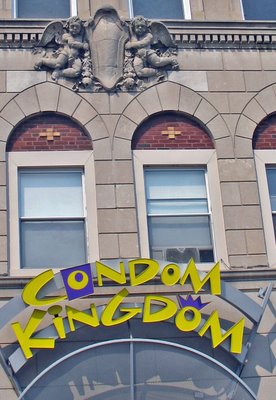
Just beyond that building, an unknown philosopher proclaimed dislike of any Categorical Imperative.

I walked westward across 4th to Market, then turned right to head towards 9th. After a couple of blocks, I paused to get my obligatory shot of Independence Hall.


Continuing across Market, I came to a magnificent example of late 19th century cast iron department store architecture. There are many buildings in this style in the "Ladies' Mile" section of New York, but I reckoned this an especially fine specimen. It is the former Lit Bros. store, now subdivided into a few street level chain shops and offices above.
Fortunately, the building has been preserved.
To the right of the "Lit's" sign facing the intersection is a sign that reads, "Hats trimmed free of charge." I wonder if Carmen Miranda ever came to Philly to take advantage of that offer.

I'm not sure why, but smaller cities like Philadelphia seem to have much more exuberant vernacular architecture than New York. Perhaps it's because architects working in cities with less critical oversight felt less inhibited.
In any event, note the "eyes" on The Quaker City National Bank Building. Revel in the playful texture of the facade, and the "thought balloon" containing the institutional name, suspended above the helmet of the figure on the keystone of the arch.
I turned left off Market onto 9th and walked southward. After a few blocks, I started to get into the heart of old Italian South Philly. Several blocks were taken over by outdoor market stalls selling produce of all descriptions.

Finally, I arrived at my destination, and found the end of a long, but fairly rapidly moving line.

The questions of the moment were Cheez-Whiz or Provolone, and "with" (or, as Topazz had coached me, "wit") or "without". (The last refers to onions.) I had read that cheesesteak cognoscienti prefer "Whiz"; the issue of onions is left to individual taste. When I got to the window, and a little, brush-cut pitbull of a man barked "Next!", I said, "One Whiz wit, please." (The last word probably gave me away as a tourist.)
The sandwich proved worth the walk and the seven bucks. The meat was sliced thin and a bit overdone for my taste. The logic of "Whiz" was readily apparent; its semiliquid state allows it to permeate every crevice, and its unsubtle flavor perked up the beef nicely. The bread was an ideal companion for these ingredients; soft and spongy, but still firm enough to keep its shape and hold the filling, while absorbing the cheese and the meat juice. The onions were a bit of a letdown -- heavily sauteed and droopy, like those you get from hot dog carts. Next time, I may try a "Whiz witout". Nevertheless, I was more than satisfied.
As I started back to my hotel, I noticed Passyunk Avenue heading off at a northeastward angle, forming a hypoteneuse to the triangle whose legs of Market and 9th I had walked to get here. At the apex of the triangle sat Pat's gaudy competitor, Geno's.

I decided to take the Passyunk shortcut, which would afford me the opportunity to see some different things on the way back. After walking a few blocks, I became very thirsty. I was sure I'd soon come to a little deli where I could get a bottle of water, but all I could find were residences and auto supply stores.
Finally, after many blocks, I saw this sign. I was ready to "take the plunge", but the plunge wasn't ready for me, as a sign on the door said the place didn't open until 5:00 P.M., and it was only 2:15.

Fortunately, after another couple of blocks, I found this angel of mercy, attended by two cherubs (one of whom is visible just inside the door) at the corner of Passyunk and Catherine.
 The lemonade they vended was a perfect chaser to a Pat's cheesesteak, having a crisp tartness that banished the lingering salinity of the Cheez-Whiz and onions.
The lemonade they vended was a perfect chaser to a Pat's cheesesteak, having a crisp tartness that banished the lingering salinity of the Cheez-Whiz and onions.Passyunk Avenue came to an end a few blocks later, near this building, on which two more cherubs fluttered in attendance on an unlikely monarchy.

Just beyond that building, an unknown philosopher proclaimed dislike of any Categorical Imperative.

Thursday, September 14, 2006
Ann Richards, 1933-2006
Back when she was governor, Ann Richards had the duty of speaking to a group of state insurance regulators who were meeting in Houston. Also in the audience were many representatives of the insurance industry and their lawyers, myself included in the last category. It was, I suppose, a fairly standard Ann Richards speech, laced with Texan expansiveness but leavened by self-deprecating humor. At one point, she suggested the need for greater government oversight of some aspect of the business. There was a moment of dead silence, then one man started clapping loudly. "You're a lo-o-o-nely fellow," she said.
Given the drift of Texas politics over the years since she left office, one might suppose she spent her later years as a lonely woman. But the progressive tradition in Texas is still very much alive. Ann Richards embodied much of what is great about a great state.
9/18 update: Interesting and amusing reminisences of Ann's post-gubernatorial days by a man who served as her personal assistant, in a blog called In the Pink Texas.
Given the drift of Texas politics over the years since she left office, one might suppose she spent her later years as a lonely woman. But the progressive tradition in Texas is still very much alive. Ann Richards embodied much of what is great about a great state.
9/18 update: Interesting and amusing reminisences of Ann's post-gubernatorial days by a man who served as her personal assistant, in a blog called In the Pink Texas.
Monday, September 11, 2006
September 11 commemoration photos.
I was going to post a few quick shots I got this morning on the way from my daughter's school at West Street and Murray to my office at 45 Broadway, But those on Gowanus Lounge are so compelling that the best I can do is direct you to them.
Remembering Charlie (9.11.06)
It’s five years since
the turbofan clatter, the sudden silence,
the loud report, the screams,
the gashed tower, the smoke,
then the flame, and the realization…
I like to imagine a time
when you, George and I
take the heavenly PATH
to celestial Hoboken, where,
at the bar of the cosmic Brass Rail,
we’ll sip ambrosial Berliner weisse.
This time, Brando will join us.
the turbofan clatter, the sudden silence,
the loud report, the screams,
the gashed tower, the smoke,
then the flame, and the realization…
I like to imagine a time
when you, George and I
take the heavenly PATH
to celestial Hoboken, where,
at the bar of the cosmic Brass Rail,
we’ll sip ambrosial Berliner weisse.
This time, Brando will join us.
Sunday, September 10, 2006
Portentous?
Monday, September 04, 2006
Why I won't give up on college football.
Earlier this evening, I was ready to write a post headed "Why I'm giving up on college football." I had turned on the TV to find Florida State, midway in the first quarter, leading Miami by a field goal. The 'Noles had the ball, deep in their territory, third and ten. The quarterback took the snap, dropped back, and, with good protection, set up and threw a perfect spiral downfield. The receiver was covered, but jumped up, and the ball hit his hands. Of course, it bounced off them and fell into the hands of a Miami defender, who fell to the ground, covering the ball and giving the 'Canes great field position. I didn't want to see the inevitable touchdown, so I turned off the tube while muttering an expletive that made my wife say something negative about my relationship to sports in general.
So it was that I began mentally drafting my explanation of why Miami owns Florida State (If you were a premier prospect, where would you rather spend four or (more likely) five years: beach 'n' bling city USA or a small metropolis in the red clay country that is subject to ice storms in winter and has government and higher education as its principal reasons for being?). And, for my coda; well, it's all just too predictable. Except when you want it to be. (For a contrary example to this rule, see here).
Anyway, I braved myself to check the late score and found the 'Noles with a 13-10 lead late in the 4th. This proved to hold, much to my surprise.
Steel yourselves. There will be more college football rants.
9/7 addendum: Reggie hits me with the "Why bother with the college game when the NFL is so much better?" meme. My short answer is, "acculturation." I got to know football as a child and youth in Florida long before there were Dolphins, Buccaneers or Jaguars. There were, however, Gators, Seminoles, Hurricanes, and even (in those days) University of Tampa Spartans. They were the ones who made the Tampa Tribune Sunday headlines. Of course, there was token coverage of the Giants, Steelers, Browns, Bears and Packers for the benefit of vacationing snowbirds.
I note that Reggie is a Tarheel, meaning he's from a place where college football has always been a poor second cousin to college basketball. It's interesting to note that North Carolina now hosts a first-rate NFL team, but the NBA couldn't succeed there. Maybe there's some kind of inverse relationship. (Yeah, but the Colts and Pacers are both good. OK, something about exceptions that prove rules?)
So it was that I began mentally drafting my explanation of why Miami owns Florida State (If you were a premier prospect, where would you rather spend four or (more likely) five years: beach 'n' bling city USA or a small metropolis in the red clay country that is subject to ice storms in winter and has government and higher education as its principal reasons for being?). And, for my coda; well, it's all just too predictable. Except when you want it to be. (For a contrary example to this rule, see here).
Anyway, I braved myself to check the late score and found the 'Noles with a 13-10 lead late in the 4th. This proved to hold, much to my surprise.
Steel yourselves. There will be more college football rants.
9/7 addendum: Reggie hits me with the "Why bother with the college game when the NFL is so much better?" meme. My short answer is, "acculturation." I got to know football as a child and youth in Florida long before there were Dolphins, Buccaneers or Jaguars. There were, however, Gators, Seminoles, Hurricanes, and even (in those days) University of Tampa Spartans. They were the ones who made the Tampa Tribune Sunday headlines. Of course, there was token coverage of the Giants, Steelers, Browns, Bears and Packers for the benefit of vacationing snowbirds.
I note that Reggie is a Tarheel, meaning he's from a place where college football has always been a poor second cousin to college basketball. It's interesting to note that North Carolina now hosts a first-rate NFL team, but the NBA couldn't succeed there. Maybe there's some kind of inverse relationship. (Yeah, but the Colts and Pacers are both good. OK, something about exceptions that prove rules?)
Steve Irwin
My daughter said she really wished I would post on my blog about him. She and I watched many of his shows on Animal Planet. I found him engaging and humorous, and admired his commitment to conservation. I think the fact that she felt so strongly about his death says something very positive about her.
9/12 update, with which I think my daughter would heartily agree.
9/12 update, with which I think my daughter would heartily agree.
Meet Wellington.
Thursday, August 31, 2006
Happy 61st, Van Morrison.
I'll never forget the first time I heard you, as I was having lunch - roast beef on a bulkie with Russian dressing - in a little sandwich shop called Hazen's, on my first day in Cambridge, Massachusetts, when someone played "Brown-Eyed Girl" on the jukebox. Little did I know that even better things were to come.
Wednesday, August 30, 2006
Blogbirthday.
Take back this pudding. It has no theme.
- attributed to Winston Churchill
One year ago tonight I started this blog. I did it because a group of posters on the Fray (the online discussion group appended to Slate magazine) was starting a writing group, and decided to publish their contributions through blogs. I had thought about blogging before, but assumed there was some financial outlay involved in getting set up. The organizer of the Fray writing group gave directions on how to set up a blog on Blogger, and I followed them. Having set the thing up, I began using it to publish whatever came across my mind, all unrelated to the writing group, to which, I'm afraid, I never contributed.
Why the awful name? Shortly before I set up the blog, I saw the phrase "self-absorbed boomer" in several contexts. I was born in 1946, so I'm on the leading edge of the post-World War 2 baby boom, and my wife does occasionally accuse me of being self-absorbed. So I put it down, with the thought that, since I wasn't likely to draw a big readership, I could always blame the blog's lack of popularity on its title (or, should it enjoy any degree of success, revel in its having succeeded despite its name). Anyway, changing it now seems like too much of a hassle.
So, what's it all about? Well, despite the name, it's nothing like Jonathan Franzen's memoir. It is self-absorbed in the sense that it includes stuff about a number of childhood fascinations that I've never lost (dinosaurs, ships, trains) as well as ones I've developed later in life (architecture, baseball, economics) which, taken together, are, if not unique to me, certainly not a constellation of interests likely to coincide with those of a very large group of people. What I'm doing is taking the long tail theory to a length it probably can't reach. If, say, someone with a strong interest in architecture hits on my blog when that's the topic of my top post, she may bookmark it and come back. But if she then finds a post about college football, she may give up on it. If this were a business, and I was depending on it for my sustenance, I'd disaggregate; that is, I'd have "Claude's Baseball Blog", "Claude's Life in Brooklyn Heights Blog", and so forth. But it's not, and I won't.
How long will I keep on doing this? So long as marginal utility > marginal cost. (Thank you, Barbara Katz and Larry White.)
One thing I am going to change. I'd like very much to hear from you; to get your reaction to the blog in general and to what I've written about it here. However, with a few exceptions (mostly fellow Fraysters), people have not been eager to leave comments. One probable reason is that I've not allowed anonymous comments. I'm going on to Blogger Dashboard now to change that. Please feel free to comment anonymously if that's the only way you're comfortable doing it.
Thank you all. Here's hoping we can do this again one year hence.
- attributed to Winston Churchill
One year ago tonight I started this blog. I did it because a group of posters on the Fray (the online discussion group appended to Slate magazine) was starting a writing group, and decided to publish their contributions through blogs. I had thought about blogging before, but assumed there was some financial outlay involved in getting set up. The organizer of the Fray writing group gave directions on how to set up a blog on Blogger, and I followed them. Having set the thing up, I began using it to publish whatever came across my mind, all unrelated to the writing group, to which, I'm afraid, I never contributed.
Why the awful name? Shortly before I set up the blog, I saw the phrase "self-absorbed boomer" in several contexts. I was born in 1946, so I'm on the leading edge of the post-World War 2 baby boom, and my wife does occasionally accuse me of being self-absorbed. So I put it down, with the thought that, since I wasn't likely to draw a big readership, I could always blame the blog's lack of popularity on its title (or, should it enjoy any degree of success, revel in its having succeeded despite its name). Anyway, changing it now seems like too much of a hassle.
So, what's it all about? Well, despite the name, it's nothing like Jonathan Franzen's memoir. It is self-absorbed in the sense that it includes stuff about a number of childhood fascinations that I've never lost (dinosaurs, ships, trains) as well as ones I've developed later in life (architecture, baseball, economics) which, taken together, are, if not unique to me, certainly not a constellation of interests likely to coincide with those of a very large group of people. What I'm doing is taking the long tail theory to a length it probably can't reach. If, say, someone with a strong interest in architecture hits on my blog when that's the topic of my top post, she may bookmark it and come back. But if she then finds a post about college football, she may give up on it. If this were a business, and I was depending on it for my sustenance, I'd disaggregate; that is, I'd have "Claude's Baseball Blog", "Claude's Life in Brooklyn Heights Blog", and so forth. But it's not, and I won't.
How long will I keep on doing this? So long as marginal utility > marginal cost. (Thank you, Barbara Katz and Larry White.)
One thing I am going to change. I'd like very much to hear from you; to get your reaction to the blog in general and to what I've written about it here. However, with a few exceptions (mostly fellow Fraysters), people have not been eager to leave comments. One probable reason is that I've not allowed anonymous comments. I'm going on to Blogger Dashboard now to change that. Please feel free to comment anonymously if that's the only way you're comfortable doing it.
Thank you all. Here's hoping we can do this again one year hence.
Tuesday, August 29, 2006
Eisenhower Lock revisited.
About a year ago, I posted about a visit to Eisenhower Lock, on the St. Lawrence Seaway at Massena, New York. What I didn't do then was document the entire process of a ship locking through. On my recent visit to Massena, I checked the traffic report on the Seaway website and noted that the Birchglen was due at the Lock in a couple of hours.
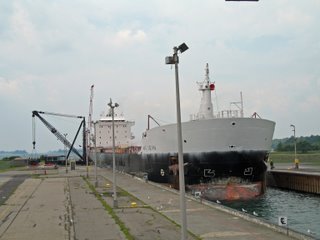 I got there in time to see her enetering the lock. Birchglen proved to be a new style Great Lakes bulk cargo carrier, or "laker", in that she has both her bridge and engine room aft instead of having a separate wheelhouse and crew quarters perched on her bow (compare with the photos of Frontenac in my earlier post linked above). In this respect, she looks like a typical oceangoing bulker; her laker pedigree is proclaimed by her very rounded bow, which contrasts with the sharper-edged stem of a typical "salty", and her relatively narrow beam compared to her length, which enables her to fit the Seaway locks.
I got there in time to see her enetering the lock. Birchglen proved to be a new style Great Lakes bulk cargo carrier, or "laker", in that she has both her bridge and engine room aft instead of having a separate wheelhouse and crew quarters perched on her bow (compare with the photos of Frontenac in my earlier post linked above). In this respect, she looks like a typical oceangoing bulker; her laker pedigree is proclaimed by her very rounded bow, which contrasts with the sharper-edged stem of a typical "salty", and her relatively narrow beam compared to her length, which enables her to fit the Seaway locks.

To the right is a closer view of Birchglen's bow, revealing a sloppy paint job covering raised metal letters spelling out her earlier name, Federal Richelieu. Sailors used to consider it bad luck to sail on a vessel if its name had been changed. Today, it is rare to find a merchant ship more than five years old that hasn't had its name (and probably its ownership) changed at least once. In fact, Birchglen was launched in 1983 as Canada Marquis, sailed under that name until 1991, when she became Federal Richelieu, had her name changed again to Federal MacKenzie in that same year (ironically, the name she bore for the shortest time is the one memorialized in raised lettering), stuck with Federal MacKenzie for ten years until becoming simply MacKenzie for the period 2001-02, then was given her present name. No wonder her owners, Canada Steamship Lines Inc., don't worry too much about the neatness of the paint job. As a lawyer, I assume this name-changing mania is driven by tax considerations, this being what seems to be behind any seemingly economically nonsensical business activity. (Information on the name chages comes from the very useful Know Your Ships: Guide to Boats & Boatwatching, Great Lakes & St. Lawrence Seaway, published by Marine Publishing Co., Inc. of Sault Ste. Marie, Michigan, and available at the Eisenhower Lock Visitor Center gift shop.)
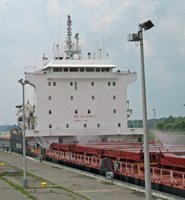
 These photos show Birchglen's superstructure in a full lock (having come in from the west), and after the lock has emptied to the level of the Seaway downstream. This lowering of a 35,000 deadweight ton vessel (or raising of a vessel going in the opposite direction) is accomplished by the force of gravity; the only electric energy used is that needed to open and close a couple of valves.
These photos show Birchglen's superstructure in a full lock (having come in from the west), and after the lock has emptied to the level of the Seaway downstream. This lowering of a 35,000 deadweight ton vessel (or raising of a vessel going in the opposite direction) is accomplished by the force of gravity; the only electric energy used is that needed to open and close a couple of valves.
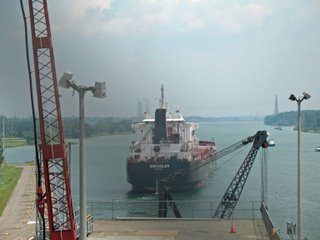
Finally, we see Birchglen, having left Eisenhower Lock, sailing down the St. Lawrence toward her destination, Quebec City, where her cargo of grain will either be transshipped onto oceangoing vessels for transport overseas, or, perhaps, be milled into flour to make baguettes for hungry Quebecois.
Update: Alert reader (and friend) Ellen tells me by e-mail that frequent ship name changes aren't tax-driven. In her words:
"As I recall from my super brief stint as a sometime admiralty lawyer (wish I'd been able really to learn the stuff; it was quirky and fascinating in many respects, though it could be frustrating as well. Because of goddamn name changes, even while the vessel was at sea, I once lost a tanker for a while), it's often that a vessel is a corporation's only asset, and when there are liens against the corp or other liabilities, the principal "transfers" the vessel to "another" corporation, changes its name, and puts the first corporation in bankruptcy. Or something like that. It wasn't as much, always, about taxes as about crookedness and avoiding liability. But maybe that kind of thing isn't as easy anymore."
Second update. A very big thank you to Homer Fink of Brooklyn Heights Blog (today featuring a photo of Robert Moses, who, coincidentally, was one of the principal promoters of the St. Lawrence Seaway, looking very predatory under his broad-brimmed fedora) for telling me how to link directly to an old post instead of to an entire month's archive. I've fixed the link in the first sentence of this post accordingly.
 I got there in time to see her enetering the lock. Birchglen proved to be a new style Great Lakes bulk cargo carrier, or "laker", in that she has both her bridge and engine room aft instead of having a separate wheelhouse and crew quarters perched on her bow (compare with the photos of Frontenac in my earlier post linked above). In this respect, she looks like a typical oceangoing bulker; her laker pedigree is proclaimed by her very rounded bow, which contrasts with the sharper-edged stem of a typical "salty", and her relatively narrow beam compared to her length, which enables her to fit the Seaway locks.
I got there in time to see her enetering the lock. Birchglen proved to be a new style Great Lakes bulk cargo carrier, or "laker", in that she has both her bridge and engine room aft instead of having a separate wheelhouse and crew quarters perched on her bow (compare with the photos of Frontenac in my earlier post linked above). In this respect, she looks like a typical oceangoing bulker; her laker pedigree is proclaimed by her very rounded bow, which contrasts with the sharper-edged stem of a typical "salty", and her relatively narrow beam compared to her length, which enables her to fit the Seaway locks.
To the right is a closer view of Birchglen's bow, revealing a sloppy paint job covering raised metal letters spelling out her earlier name, Federal Richelieu. Sailors used to consider it bad luck to sail on a vessel if its name had been changed. Today, it is rare to find a merchant ship more than five years old that hasn't had its name (and probably its ownership) changed at least once. In fact, Birchglen was launched in 1983 as Canada Marquis, sailed under that name until 1991, when she became Federal Richelieu, had her name changed again to Federal MacKenzie in that same year (ironically, the name she bore for the shortest time is the one memorialized in raised lettering), stuck with Federal MacKenzie for ten years until becoming simply MacKenzie for the period 2001-02, then was given her present name. No wonder her owners, Canada Steamship Lines Inc., don't worry too much about the neatness of the paint job. As a lawyer, I assume this name-changing mania is driven by tax considerations, this being what seems to be behind any seemingly economically nonsensical business activity. (Information on the name chages comes from the very useful Know Your Ships: Guide to Boats & Boatwatching, Great Lakes & St. Lawrence Seaway, published by Marine Publishing Co., Inc. of Sault Ste. Marie, Michigan, and available at the Eisenhower Lock Visitor Center gift shop.)

 These photos show Birchglen's superstructure in a full lock (having come in from the west), and after the lock has emptied to the level of the Seaway downstream. This lowering of a 35,000 deadweight ton vessel (or raising of a vessel going in the opposite direction) is accomplished by the force of gravity; the only electric energy used is that needed to open and close a couple of valves.
These photos show Birchglen's superstructure in a full lock (having come in from the west), and after the lock has emptied to the level of the Seaway downstream. This lowering of a 35,000 deadweight ton vessel (or raising of a vessel going in the opposite direction) is accomplished by the force of gravity; the only electric energy used is that needed to open and close a couple of valves.
Finally, we see Birchglen, having left Eisenhower Lock, sailing down the St. Lawrence toward her destination, Quebec City, where her cargo of grain will either be transshipped onto oceangoing vessels for transport overseas, or, perhaps, be milled into flour to make baguettes for hungry Quebecois.
Update: Alert reader (and friend) Ellen tells me by e-mail that frequent ship name changes aren't tax-driven. In her words:
"As I recall from my super brief stint as a sometime admiralty lawyer (wish I'd been able really to learn the stuff; it was quirky and fascinating in many respects, though it could be frustrating as well. Because of goddamn name changes, even while the vessel was at sea, I once lost a tanker for a while), it's often that a vessel is a corporation's only asset, and when there are liens against the corp or other liabilities, the principal "transfers" the vessel to "another" corporation, changes its name, and puts the first corporation in bankruptcy. Or something like that. It wasn't as much, always, about taxes as about crookedness and avoiding liability. But maybe that kind of thing isn't as easy anymore."
Second update. A very big thank you to Homer Fink of Brooklyn Heights Blog (today featuring a photo of Robert Moses, who, coincidentally, was one of the principal promoters of the St. Lawrence Seaway, looking very predatory under his broad-brimmed fedora) for telling me how to link directly to an old post instead of to an entire month's archive. I've fixed the link in the first sentence of this post accordingly.
New dino species found in Brazil.
South America seems to be the hot spot these days for dinosaur discoveries. At 39 feet and nine tons, Maxakalisaurus topai isn't particularly big as sauropods go, but this Reuters article points out, it's a significant discovery because it appears to provide an evolutionary link to a branch of the Titanosauridae found in more recent Cretaceous formations in Argentina.
Kids may love or hate it based on its name. I'm not sure how the Maxakali, the tribe from which the name is derived, pronounce the "X"; i.e., is it "Macks-a-kal-i" or "Mash-a-kal-i"?
I'm very impressed by the reconstruction of the head of the theropod Mapusaurus roseae, which you can find by scrolling down a bit in the linked article.
Kids may love or hate it based on its name. I'm not sure how the Maxakali, the tribe from which the name is derived, pronounce the "X"; i.e., is it "Macks-a-kal-i" or "Mash-a-kal-i"?
I'm very impressed by the reconstruction of the head of the theropod Mapusaurus roseae, which you can find by scrolling down a bit in the linked article.
Saturday, August 26, 2006
Riding Amtrak's Adirondack.
Amtrak's Adirondack runs daily, both ways, between New York City's Penn Station and Montreal. The northbound and southbound trains both leave early in the morning and arrive at their destinations in the evening. This allows passengers to enjoy some impressive scenery along the way. The conductor announced that the train had been named by National Geographic Traveler magazine as having one of the five most scenic routes in the world, which, he noted, put it in the same category as the Orient Express. If only its accomodations were as posh as those on the Direct-Orient, to use (for you persnickety railfans) its proper name. Nevertheless, for Amtrak, this is a pretty good operation. The equipment is standard, i.e. basic aging Amfleet coaches (this route cries for domes; alas, tunnel clearances don't allow them) (Update: According to Trains magazine, a dome car will be added to the train during the fall foliage season, but only for the route between Albany and Montreal, where tunnel clearances are sufficient), but the crew, at least on this run, was top notch. Rating special mention are Pat, the conductor from Albany to points north, whose thirty-eight year career extends back to the days when passenger service on this part of the route was provided by the Delaware & Hudson, and the cafe car attendant, identified by his badge as Mr. Graves, whose limited counter space and food-heating facilities were taxed by a crowded train, but who dealt with the impatient and sometimes cranky passengers with grace and humor.
Subway delays meant I made the Adirondack's 7:45 A.M. departure with seconds to spare, so I was forced to take an aisle seat. Consequently, I wasn't able to get photos of the first stretch of great scenery: the Hudson valley between New York City and Albany. As we approched the Hudson Highlands, the conductor announced that volunteers from the National Park Service would give a narrative about the historical and geological significance of the places we were passing, and that those wishing to hear it should gather at the rear of the cafe car. By the time I got there, all the seats were taken, so I returned to my coach and waited until we reached Albany/Rensselaer, a division point where there's both a crew and engine change, the latter meaning we swapped one GE Genesis type loco for another.
My first visit to this station was in 1970 or '71, when, as a first year associate in a New York City law firm, I was sent to Albany to do research on the legislative history of an obscure tax statute. This was before Amtrak, so the train I rode was operated by Penn Central, then on its last legs. When I got off, I saw across two tracks an A/A pair of Alco PAs in Delaware & Hudson colors, but in livery that was an obvious copy of the Santa Fe's "Warbonnet" scheme (see photo below, by J. Testagrose, which is courtesy of Brent Holt's Exotic Diesel site (the link is to the PA page), sponsored by The Railfan Network.)
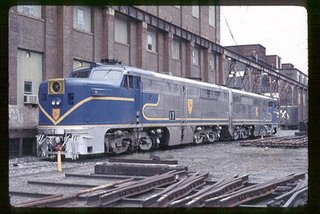
I later learned why: D&H's PAs were purchased from Santa Fe, so the paint scheme they bore was basically a matter of putting blue over red. Indeed, I may have seen these same PAs heading AT&SF's Grand Canyon at its terminus when my parents and I visited the Canyon several years before.

The PA is regarded by many railfans as the best looking diesel ever made. To my eye, the Genesis (see left), while not so handsome as the PA, has a similar austere elegance. It's certainly an improvement on the clunky looking FP-40 that preceded it. Its sculptured lines suggest my own favorite of the first generation diesels, the Baldwin "Sharknose" (see photo below, by J. Hunt, again courtesy of Exotic Diesel), minus the nose.

After leaving Albany/Rensellaer station, we crossed the Hudson just north of downtown Albany, then headed west to Schenectady. Following a stop there, we turned north again towards Saratoga. Shortly after, Pat the conductor announced that a National Park Service volunteer would be in the front coach to talk about sights along the way. This time, I was able to find a seat. The volunteer, Dave, was a high school teacher from Schenectady. The first thing he said after I took my seat confirmed what I had suspected, that the abandoned industrial complex we had passed just after leaving Schenectady station was the American Locomotive Works ("Alco"), birthplace of the PA and many other steam and diesel locos.
As we approached Saratoga, Dave talked about the significance of the Revolutionary War battle fought there, in which Benedict Arnold, along with Horatio Gates, got credit for a victory which thwarted the British plan to isolate New England from the colonies to the south. He then discussed theories about Arnold's later turn to treachery, noting that the most plausible was his wife's hatred of their subsequent post at West Point. Arnold had sustained a wound at Saratoga that necessitated the amputation of his right leg, and there is now a monument at the Saratoga Battlefield National Historical Site to that booted leg, the only part of him, as Dave said, that never betrayed the revolutionary cause.

A short time after leaving Saratoga, we re-crossed the Hudson, now running almost west to east after descending soutwestwards from its source in Lake Tear of the Clouds, in the High Peaks region of the Adirondacks. What you see in the photo on the right is just the southern part of the river, as the far bank is Rogers Island, a place steeped in the history of the French and Indian War, as well as the ancestral home of the U.S. Army Rangers.
North of Rogers Island our route was parallel to the Champlain Canal, which connected the Hudson with Lake Champlain. This, along with another short canal bypassing rapids on the Richelieu River, through which Lake Champlain drains into the St. Lawrence, enabled watercraft to travel from New York City (or, later, after completion of the Erie Canal, from Buffalo and points on the Great Lakes to the west) to Montreal, or down the St. Lawrence to Quebec City.
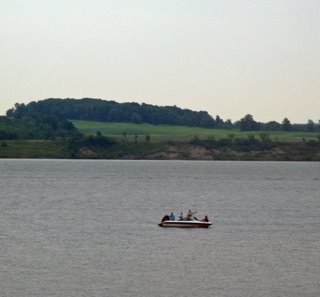 As we continued northward, the canal broadened into what seemed a wide river, but was actually the southern part of Lake Champlain. The woods and green pasture on the opposite bank are in Vermont, which, as Dave noted, was not one of the thirteen rebellious colonies. In fact, it was for a time an independent republic.
As we continued northward, the canal broadened into what seemed a wide river, but was actually the southern part of Lake Champlain. The woods and green pasture on the opposite bank are in Vermont, which, as Dave noted, was not one of the thirteen rebellious colonies. In fact, it was for a time an independent republic.
One of our stops on the west bank of Champlain was Port Henry, where there is a museum commemorating the Lake Champlain & Moriah, a mining railroad that hauled iron ore from a mine to the west to the Champlain shore, where it was loaded onto boats for transport north to Canada or south through the canal to the Hudson or the Erie. Below are photos of the rolling stock on display, which include an Alco freight engine, an ore bogey and a caboose; unfortunately, it was raining at the time I took them, and drops on the coach windows affect the quality of the images (there was no time to detrain there). (Update: for better photos, taken the following summer and winter, see here and here.)

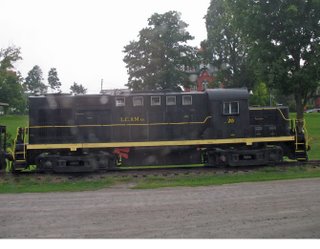

At Westport, Pat announced that there would be time to get off and stretch our legs or placate our nicotine cravings. This allowed me to get
a shot of the still functional Victorian depot there.
Shortly after Westport, we reached my destination, Plattsburgh. The following afternoon, I got the photo below of the southbound Adirondack arriving at Plattsburgh station. The monument in the background, surmounted by an eagle, commemorates the Revolutionary War capture of Fort Ticonderoga, which lies some seventy miles to the south, and is briefly visible from the train.

Update: for more photos and text from a later journey on the Adirondack, see here For a video showing scenery along the lower Hudson Valley taken from the train, along with an interview of your correspondent by a Wall Street Journal reporter, see here.
Subway delays meant I made the Adirondack's 7:45 A.M. departure with seconds to spare, so I was forced to take an aisle seat. Consequently, I wasn't able to get photos of the first stretch of great scenery: the Hudson valley between New York City and Albany. As we approched the Hudson Highlands, the conductor announced that volunteers from the National Park Service would give a narrative about the historical and geological significance of the places we were passing, and that those wishing to hear it should gather at the rear of the cafe car. By the time I got there, all the seats were taken, so I returned to my coach and waited until we reached Albany/Rensselaer, a division point where there's both a crew and engine change, the latter meaning we swapped one GE Genesis type loco for another.

My first visit to this station was in 1970 or '71, when, as a first year associate in a New York City law firm, I was sent to Albany to do research on the legislative history of an obscure tax statute. This was before Amtrak, so the train I rode was operated by Penn Central, then on its last legs. When I got off, I saw across two tracks an A/A pair of Alco PAs in Delaware & Hudson colors, but in livery that was an obvious copy of the Santa Fe's "Warbonnet" scheme (see photo below, by J. Testagrose, which is courtesy of Brent Holt's Exotic Diesel site (the link is to the PA page), sponsored by The Railfan Network.)

I later learned why: D&H's PAs were purchased from Santa Fe, so the paint scheme they bore was basically a matter of putting blue over red. Indeed, I may have seen these same PAs heading AT&SF's Grand Canyon at its terminus when my parents and I visited the Canyon several years before.

The PA is regarded by many railfans as the best looking diesel ever made. To my eye, the Genesis (see left), while not so handsome as the PA, has a similar austere elegance. It's certainly an improvement on the clunky looking FP-40 that preceded it. Its sculptured lines suggest my own favorite of the first generation diesels, the Baldwin "Sharknose" (see photo below, by J. Hunt, again courtesy of Exotic Diesel), minus the nose.

After leaving Albany/Rensellaer station, we crossed the Hudson just north of downtown Albany, then headed west to Schenectady. Following a stop there, we turned north again towards Saratoga. Shortly after, Pat the conductor announced that a National Park Service volunteer would be in the front coach to talk about sights along the way. This time, I was able to find a seat. The volunteer, Dave, was a high school teacher from Schenectady. The first thing he said after I took my seat confirmed what I had suspected, that the abandoned industrial complex we had passed just after leaving Schenectady station was the American Locomotive Works ("Alco"), birthplace of the PA and many other steam and diesel locos.
As we approached Saratoga, Dave talked about the significance of the Revolutionary War battle fought there, in which Benedict Arnold, along with Horatio Gates, got credit for a victory which thwarted the British plan to isolate New England from the colonies to the south. He then discussed theories about Arnold's later turn to treachery, noting that the most plausible was his wife's hatred of their subsequent post at West Point. Arnold had sustained a wound at Saratoga that necessitated the amputation of his right leg, and there is now a monument at the Saratoga Battlefield National Historical Site to that booted leg, the only part of him, as Dave said, that never betrayed the revolutionary cause.

A short time after leaving Saratoga, we re-crossed the Hudson, now running almost west to east after descending soutwestwards from its source in Lake Tear of the Clouds, in the High Peaks region of the Adirondacks. What you see in the photo on the right is just the southern part of the river, as the far bank is Rogers Island, a place steeped in the history of the French and Indian War, as well as the ancestral home of the U.S. Army Rangers.
North of Rogers Island our route was parallel to the Champlain Canal, which connected the Hudson with Lake Champlain. This, along with another short canal bypassing rapids on the Richelieu River, through which Lake Champlain drains into the St. Lawrence, enabled watercraft to travel from New York City (or, later, after completion of the Erie Canal, from Buffalo and points on the Great Lakes to the west) to Montreal, or down the St. Lawrence to Quebec City.
 As we continued northward, the canal broadened into what seemed a wide river, but was actually the southern part of Lake Champlain. The woods and green pasture on the opposite bank are in Vermont, which, as Dave noted, was not one of the thirteen rebellious colonies. In fact, it was for a time an independent republic.
As we continued northward, the canal broadened into what seemed a wide river, but was actually the southern part of Lake Champlain. The woods and green pasture on the opposite bank are in Vermont, which, as Dave noted, was not one of the thirteen rebellious colonies. In fact, it was for a time an independent republic.One of our stops on the west bank of Champlain was Port Henry, where there is a museum commemorating the Lake Champlain & Moriah, a mining railroad that hauled iron ore from a mine to the west to the Champlain shore, where it was loaded onto boats for transport north to Canada or south through the canal to the Hudson or the Erie. Below are photos of the rolling stock on display, which include an Alco freight engine, an ore bogey and a caboose; unfortunately, it was raining at the time I took them, and drops on the coach windows affect the quality of the images (there was no time to detrain there). (Update: for better photos, taken the following summer and winter, see here and here.)



At Westport, Pat announced that there would be time to get off and stretch our legs or placate our nicotine cravings. This allowed me to get
a shot of the still functional Victorian depot there.
Shortly after Westport, we reached my destination, Plattsburgh. The following afternoon, I got the photo below of the southbound Adirondack arriving at Plattsburgh station. The monument in the background, surmounted by an eagle, commemorates the Revolutionary War capture of Fort Ticonderoga, which lies some seventy miles to the south, and is briefly visible from the train.

Update: for more photos and text from a later journey on the Adirondack, see here For a video showing scenery along the lower Hudson Valley taken from the train, along with an interview of your correspondent by a Wall Street Journal reporter, see here.
Thursday, August 24, 2006
Clyde Tombaugh: a distinguished life in astronomy.
The decision by a council of astronomers meeting in Prague to demote Pluto to "dwarf planet" status brings to mind the remarkable man who discovered the little devil some seventy six years ago. Clyde Tombaugh secured his job as an assistant at Harvard's Lowell Observatory on the strength of some sketches of planets he had made based on observations through a home-made telescope. He was only 24 when he compared some photographic plates and noticed a dim object that moved in the manner to be expected of a distant planet. He has ever since been remembered as the discoverer of Pluto, but, as this brief biography points out, made many other contributions to our knowledge of the universe during his long career, including delineating a supercluster of galaxies spanning the sky from Andromeda to Perseus.
Here's hoping that the reclassification of Pluto doesn't dim the memory of this fine man, who died nine years ago at the age of 90.
Here's hoping that the reclassification of Pluto doesn't dim the memory of this fine man, who died nine years ago at the age of 90.
Subscribe to:
Posts (Atom)



